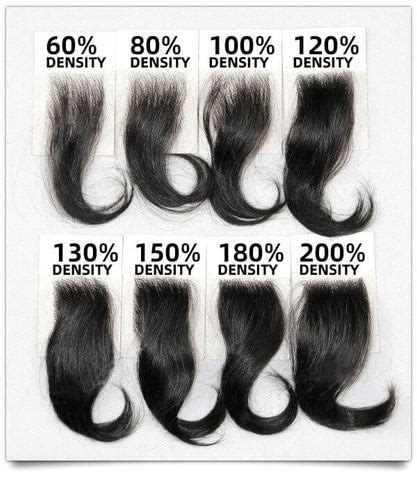Understanding Wig Density: 101
In the world of wigs, density refers to the number of hairs per square inch of the wig’s base. The higher the density, the thicker and fuller the wig will appear. Two common densities are 180% and 260%.

180 Density Wigs
Pros:
- Lightweight and breathable: 180% density wigs are less bulky, making them more comfortable to wear for extended periods.
- Natural-looking: The lower density allows for natural scalp visibility and movement, creating a more realistic appearance.
- Versatile: 180% density wigs are suitable for various hairstyles, from sleek and polished to voluminous and bouncy.
Cons:
- May appear thin: In certain lighting or from certain angles, 180% density wigs may appear thinner than desired.
- Limited volume: For individuals seeking maximum volume and thickness, 180% density may not provide the desired fullness.
260 Density Wigs
Pros:
- Maximum volume and fullness: With 260% density, the wig creates an incredibly thick and voluminous look, perfect for individuals who want to make a bold statement.
- Hides scalp visibility: The high density effectively covers the wearer’s scalp, providing a more opaque and seamless appearance.
- Ideal for high-impact hairstyles: 260% density wigs excel in hairstyles that require extra volume, such as afros, ponytails, and high buns.
Cons:
- Heavy and warm: The increased density makes 260% density wigs heavier and warmer to wear, especially in humid climates.
- Can appear unnatural: In certain hairstyles or lighting conditions, 260% density wigs may look excessively thick or unnatural.
- More expensive: Higher density wigs generally carry a higher price tag due to the increased material and labor involved in their construction.
Which Density is Right for You?
The best density for you depends on your individual preferences and needs:
- Thin or fine hair: 180% density will provide a natural and flattering look, adding fullness without overwhelming your own hair.
- Average hair: Both 180% and 260% density can work well, depending on your desired volume and style.
- Thick or coarse hair: A 260% density wig can provide extra thickness and volume, helping to balance out your own hair’s texture.
Common Mistakes to Avoid
- Choosing the wrong density for your hair type: If you have thin or fine hair, a high-density wig can appear fake and overwhelming.
- Over-styling: Excessive heat styling or brushing can damage high-density wigs and shorten their lifespan.
- Improper care: Neglecting proper care, such as cleaning and conditioning, can reduce the wig’s longevity and appearance.
Tips and Tricks
- Consider your hair type and desired volume: Think about the thickness of your own hair and the level of fullness you want to achieve.
- Try on different densities: If possible, try on both 180% and 260% density wigs to see what feels most comfortable and flattering.
- Experiment with styles: Don’t limit yourself to one hairdo. Explore different styles and adjust the density accordingly to create a variety of looks.
Table 1: Density Comparison
| Density | Weight | Breathability | Volume | Realism | Price |
|---|---|---|---|---|---|
| 180% | Lighter | More breathable | Moderate | Natural | Lower |
| 260% | Heavier | Less breathable | High | Less natural | Higher |
Table 2: Density Recommendations by Hair Type
| Hair Type | Ideal Density |
|---|---|
| Thin or fine | 180% |
| Average | 180% or 260% |
| Thick or coarse | 260% |
Table 3: Density for Specific Hairstyles
| Hairstyle | Ideal Density |
|---|---|
| Natural and sleek | 180% |
| Voluminous and bouncy | 260% |
| High buns and ponytails | 260% |
| Afros | 260% |
Table 4: Density Conversion Chart
| Original Density | Equivalent Density |
|---|---|
| 100% | Very light |
| 120% | Light |
| 150% | Medium-light |
| 180% | Medium |
| 200% | Medium-high |
| 260% | High |
| 300% | Very high |
